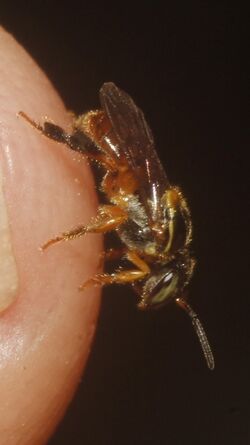Biology:Plebeia
| Plebeia | |
|---|---|

| |
| Plebeia pulchra | |
| Scientific classification | |
| Domain: | Eukaryota |
| Kingdom: | Animalia |
| Phylum: | Arthropoda |
| Class: | Insecta |
| Order: | Hymenoptera |
| Family: | Apidae |
| Tribe: | Meliponini |
| Genus: | Plebeia Schwarz, 1938 |
| Species | |
|
~45 species; see text | |
Plebeia is a genus of mostly small-bodied stingless bees, formerly included in the genus Trigona. Most of the ~45 species are placed in the subgenus (Plebeia) (s.s.), but there also are four species in the subgenus (Scaura). They differ in only minor structural details, primarily of the hind leg, from other genera that were formerly treated as constituents of Trigona. In some classifications, the genus Schwarziana is treated as a subgenus within Plebeia, but recent morphological analyses indicate that Schwarziana is a distinct lineage, while Plebeia is paraphyletic.[1]
Due to their small sizes, in Brazil many species are known as abelha-mirim (literally "small bee") in Portuguese.
Range
Species of the genus Plebeia occur from Mexico to Argentina.
A few feral colonies of P. emerina exist in the United States, the result of experimental imports in the 1950s.[2][3]
List of species
- P. alvarengai Moure, 1995
- P. amydra Engel, 2022
- P. asthenes Engel, 2021
- P. aurantia (Engel, 2022) [Now placed in genus Plectoplebeia]
- P. catamarcensis (Holmberg, 1903)
- P. chondra Engel, 2021
- P. cora Ayala, 1999
- P. deceptrix Engel, 2022
- P. domiciliorum (Schwarz, 1934)
- P. droryana (Friese, 1900)
- P. emerina (Friese, 1900)
- P. emerinoides (Silvestri, 1902)
- P. flavocincta (Cockerell, 1912)
- P. franki (Friese, 1900)
- P. frontalis (Friese, 1911)
- P. fulvopilosa Ayala, 1999
- P. goeldiana (Friese, 1900)
- P. grapiuna Melo & Costa, 2009
- P. guazurary Alvarez, Rasmussen, & Abrahamovich, 2016
- P. hyperplastica Engel, 2022
- P. jatiformis (Cockerell, 1912)
- P. julianii Moure, 1962
- P. kerri Moure, 1950
- P. llorentei Ayala, 1999
- P. lucii Moure, 2004
- P. malaris Moure, 1962
- P. manantlensis Ayala, 1999
- P. margaritae Moure, 1962
- P. melanica Ayala, 1999
- P. meridionalis (Ducke, 1916)
- P. mexica Ayala, 1999
- P. minima (Gribodo, 1893)
- P. molesta (Puls, 1869)
- P. mosquito (Smith, 1863)
- P. moureana Ayala, 1999 [Now placed in genus Asperplebeia]
- P. mutisi Engel, 2022
- P. nigriceps (Friese, 1901)
- P. nigrifacies (Friese, 1900) [Now placed in genus Plectoplebeia]
- P. orphne Engel, 2021
- P. parkeri Ayala, 1999
- P. peruvicola Moure, 1995
- P. phrynostoma Moure, 2004
- P. plectoforma Engel, 2022
- P. pleres Engel, 2021
- P. poecilochroa Moure & Camargo, 1995
- P. pulchra Ayala, 1999
- P. remota (Holmberg, 1903)
- P. roubiki Engel, 2022
- P. saiqui (Friese, 1900)
- P. silveirai Engel, 2022
- P. tica (Wille, 1969) [Now placed in genus Asperplebeia]
- P. tigris Engel, 2022
- P. tobagoensis Moure, 2003
- P. variicolor (Ducke, 1916)
- P. vidali Engel, 2022
- P. wittmanni Moure & Camargo, 1989
References
- ↑ Melo, Gabriel A.R. (October 2015). "New species of the stingless bee genus Schwarziana (Hymenoptera, Apidae)". Revista Brasileira de Entomologia 59 (4): 290–293. doi:10.1016/j.rbe.2015.08.001.
- ↑ Agarwal, Robin (3 June 2021). "New Colony of Rare Bees Found By a Four-Year-Old". https://baynature.org/2021/06/03/new-colony-of-a-rare-stingless-bee-once-presumed-absent-from-california-found-by-a-four-year-old-in-palo-alto/.
- ↑ Davies, Erica. "4-year-old girl discovers rare stingless bees in California". https://news.yahoo.com/4-old-girl-discovers-rare-145600594.html.
- ↑ "ITIS Standard Report Page: Plebeia". https://www.itis.gov/servlet/SingleRpt/SingleRpt?search_topic=TSN&search_value=634277. Retrieved 2015-11-06.
- ↑ Grüter, Christoph (2020). Stingless Bees: Their Behaviour, Ecology and Evolution. Fascinating Life Sciences. Springer New York. doi:10.1007/978-3-030-60090-7. ISBN 978-3-030-60089-1. https://link.springer.com/book/10.1007%2F978-3-030-60090-7#toc.
Wikidata ☰ Q4047085 entry
 |

